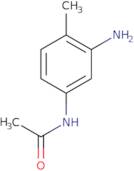
Información del producto
- 1-(2-Fluorophenyl)-3-{5-[(4-Nitrophenoxy)Methyl]-1,3,4-Thiadiazol-2-Yl}Urea
- 2-Amino-4-acetylaminotoluene
- 3'-Amino-4'-methylacetanilide
- 3′-Amino-p-acetotoluidide
- 4-Acetylamino-2-aminotoluene
- 4-Acetylamino-2-toluidine
- 5-Acetamido-2-methylaniline
- Acetamide, N-(3-amino-4-methylphenyl)-
- Acetanilide, 3'-amino-4'-methyl-
- Ba 8315
- Ver más sinónimos
- Brn 2804114
- Ccris 2681
- N,N'-(2,2-dimethylpropane-1,3-diyl)bis(3-phenylprop-2-enamide)
- p-Acetotoluidide, 3′-amino-
Acetaminophen, also known as paracetamol, is a widely used drug for pain relief and fever reduction. It is metabolized by the liver, mainly through the cytochrome P450 pathway. The cytochrome P450 pathway produces reactive intermediates that can cause oxidative stress and DNA damage. Acetaminophen has been shown to be toxic to rat primary hepatocytes in vitro at concentrations of 40-160 μM after 24 hours. Acetaminophen has also been shown to be mutagenic and carcinogenic in rats at doses of 5000 mg/kg/day, which is equivalent to a human dose of 160 mg/kg/day or higher. These effects are due to acetaminophen’s metabolic activation by reactive oxygen species (ROS) and its ability to induce cytotoxicity and oxidative stress in cells.
Propiedades químicas
Consulta técnica sobre: 3D-GAA37516 N-(3-Amino-4-methylphenyl)acetamide
Si desea solicitar un presupuesto o realizar un pedido, por favor añada los productos deseados a su carrito y solicite un presupuesto o pedido desde el carrito. Es más rápido, más barato, y podrá beneficiarse de los descuentos y las ventajas disponibles.





